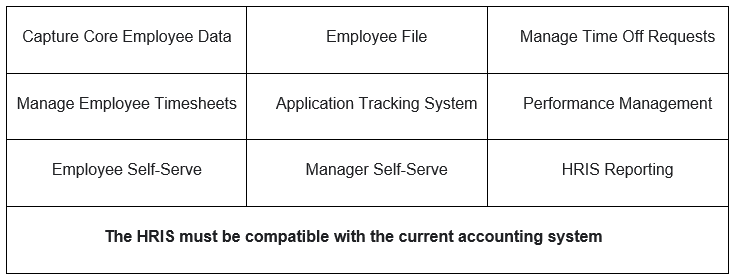
A Case Study of an HRIS Implementation

Author: Ada Tai
Has your organization considered adopting a Human Resource Information System (HRIS)? Selecting and implementing HRIS has become a trendy topic in recent years. Employers recognize the need to enhance workplace efficiency and accuracy through integrated business applications that are reliable and user-friendly. In this blog, I will share a case study of one of our clients who is implementing an HRIS for the first time and several “aha” moments along the journey.
Background:
Company XYZ is a value-based organization. The company experienced positive growth in the last five years: it grew its employee base from 30 to just under 100 and maintained a roster of 30 subcontractors/freelancers. Until early 2022, the accounting system was used for employee expenses and payroll. Recruitment, employee files, performance review and other employee data management functions were still done manually. Furthermore, reporting and benefits administration were handled by two other systems. Unsurprisingly, employee timesheets and time off requests were managed using Excel and email.
The Accounting team spent endless hours every month managing multiple systems, retrieving information from one system to feed into another, and ensuring data integrity and accuracy. Managers were concerned about the inefficiency and security risk of the current method. Additionally, leaders contemplated the need for better decision-making and future scalability as the company projects a 60 - 70% headcount growth in the coming three years.
Initial Action:
We were lucky that this was a long-term client of our company, so we were familiar with their business environment and the employee situation. Two people from our firm were assigned to this project, one being the project lead and the other person providing support. After obtaining the budget, we created a cost estimate and a project plan with major timelines, milestones, people and resources needed. Then we dived into “Needs Assessment” understanding and business requirements gathering.
Needs Assessment:
1. We sent out a questionnaire to four types of users in the company to understand what the “must-have” functions and “nice-to-have” functions are. The users include:
a) Frontline employees (end-users)
b) Supervisors & managers (end-users & approvers)
c) Accounting, IT, Administration (Functional users)
d) Leaders (end-users, approvers & ability to oversee everything)
2. After compiling the information, we identified the top “must-have” functions as:

The following were the “nice-to-have” functions:

3. We then facilitated a focus group meeting and five one-on-one meetings with leaders, functional users, and selected supervisors and staff to deep dive into their needs.
Vendor Selection:
1. With all the information collected, we quickly narrowed the selection to the top five vendors.
2. We then sent the short-listed vendors to confirm their functionality, pricing, and customer service approach. Then our team watched their live demonstrations. Given our familiarity with the company culture and employee demographics, we knew only certain vendor systems would match the client’s needs, and the user interface must be extremely intuitive.
3. We reported our findings and recommendations to the company. The top two vendors were brought in for live presentations and demonstrations.
- After both demonstrations, we asked the audience to provide ratings and feedback.
4. Once the top vendor was selected, the company representative negotiated and signed the vendor agreement.
 When evaluating vendor pricing, a few factors should be taken into account: Company location, Cost per employee, Monthly cost, Implementation fee, Total cost of the first year, Total annual cost from the second year on.
When evaluating vendor pricing, a few factors should be taken into account: Company location, Cost per employee, Monthly cost, Implementation fee, Total cost of the first year, Total annual cost from the second year on.
 After confirming the functionalities of the selected HRIS, the company reviewed the current systems, their pricing, effectiveness, vendor relationship and contract terms, and decided as to which current systems would stay and which systems would be phased out over the coming period of time.
After confirming the functionalities of the selected HRIS, the company reviewed the current systems, their pricing, effectiveness, vendor relationship and contract terms, and decided as to which current systems would stay and which systems would be phased out over the coming period of time.
If someone thinks that selecting a system is the end of a complex project, it is only the beginning of it…
Implementation:
1. The company assembled a 4-people Implementation Team, which includes a manager, an employee, an accounting person and an IT staff.
2. We then worked with the Implementation Team to decide on a department in the company that works the best as the Test Department for user/usability testing. Since HRIS systems nowadays are more intuitive, most vendors do not provide user training or training manuals. The Test Department we selected had more tech-savvy employees inclined to adapt to change.
3. The Implementation Team and our team then prepared information to transfer to the new system and converted the company’s historical data into the new system.
4. Working with the vendor, we did a “soft launch” of the new system with the Test Department for three months. The existing systems were operating at the same time. During these three months, we learned what worked well and what needed adjustment. We also gathered the Test Department staff’s feedback on a bi-weekly basis. We then worked with the vendor to ensure a smooth transition to the official launch.
5. In the fourth month, the new HRIS was officially in operation! The launch party was a lot of fun and got people’s attention. During the initial period after the launch, the Implementation Team, the Test Department and our team addressed questions from the staff. The existing systems would still be in operation for another 6 months to ensure a smooth transition and backup.
 Having a Test Department is a critical element to success: It ensures early adopters get a chance to use and review the new system, feed information as to what needs to be adjusted and help the company set the stage for the official launch. For large organizations with change management challenges, the Test Department also serves as the company’s influencing force for the rest of the employees/users.
Having a Test Department is a critical element to success: It ensures early adopters get a chance to use and review the new system, feed information as to what needs to be adjusted and help the company set the stage for the official launch. For large organizations with change management challenges, the Test Department also serves as the company’s influencing force for the rest of the employees/users.
 Taking into account the cost of the Implementation Team and consultants’ time in the company’s HRIS budget is key.
Taking into account the cost of the Implementation Team and consultants’ time in the company’s HRIS budget is key.
What's now?
So far, so good! After the official launch, several training sessions were delivered to ensure a comfortable transition for employees and managers. A quarterly check-in and a formal new system evaluation were also planned to help the Implementation Team gather information and make adjustments as needed.
Selecting and implementing HRIS system is a costly and complex project! Each organization has its unique needs, budget and challenges. Having a structured project plan and a methodical approach will help ensure businesses’ success.
I see. I hear. I experience. is a column created by and written by Ada Tai, a chartered member of CPHR Alberta. The column is written in a blog format where Ada and invited co-authors will present their own experiences and interpretations of the world of human resources and its impact on business management. This and the subsequent posts are copyrighted materials by the author(s) and only reflect their personal views, not CPHR Alberta’s.
Author bio: With an MBA Degree, a CPHR, and an SHRM-SCP designation, Ada Tai has been working as an HR professional in a variety of industries for 15 years. Through her consulting firm, Ada and the team provide various strategic and pragmatic management consulting services. Ada’s public speaking skills have enabled her to be regularly invited to speak about HR, people management, career search, and networking topics throughout the province. She is also a well-respected Instructor at the University of Alberta and MacEwan University.
Contact information:
- Website: www.badab101.com
- LinkedIn: adatai or BadaB-Consulting-Inc
- Facebook: @badabconsulting
- YouTube: BadaB Consulting Inc.
BadaB Consulting Inc. provides a wide range of human resources solutions, including Strategic HR and Succession Planning, Organizational Design & Development, Merger & Acquisition Support, Recruitment, Skills Development Training, Compensation Design, Performance Management, Workplace Investigation, Policy Development, etc. Another specialty of BadaB’s services is personal job search and career coaching. The team has effectively helped over 500 people to find work.
The views and opinions expressed in this blog post belong solely to the original author(s) and do not necessarily represent the views and opinions of CPHR Alberta.
The views and opinions expressed in this blog post belong solely to the original author(s) and do not necessarily represent the views and opinions of CPHR Alberta.





